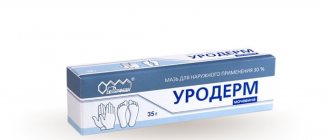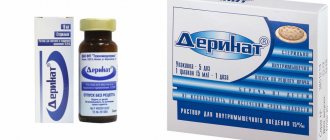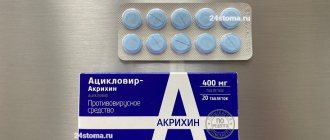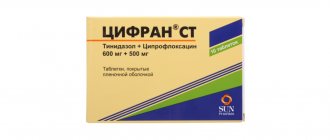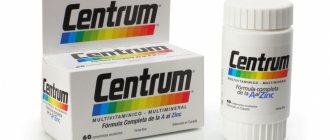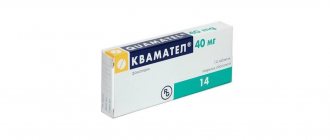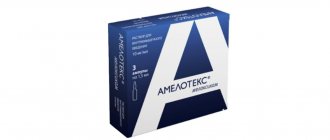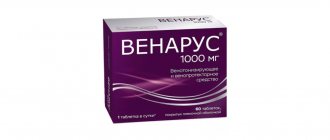Treating ARVI, influenza and other viral infections is usually more difficult than preventing them, especially in childhood. For successful prevention, take drugs with an immunomodulatory effect, for example, Viferon ointment. This is an inexpensive and quite effective drug that can be used not only by adults, but also by newborns, including premature babies.
Brief instructions for use
Instructions for use of VIFERON suppositories for children
| Is it possible to use VIFERON suppositories to treat infants and newborns? At what age can the drug be given to children? This antiviral drug can be used to treat ARVI and influenza, as well as to treat herpes and other diseases, starting from the first days of a child’s life, as well as to treat older children. | |
| Disease | Mode of application |
| ARVI, including influenza, including those complicated by bacterial infection, pneumonia | Children under 7 years old, incl. newborns and premature infants with a gestational age of more than 34 weeks , Viferon 150,000 IU is prescribed, 1 suppository 2 times a day every 12 hours every day for 5 days. According to clinical indications, therapy can be continued. The break between courses is 5 days. Recommended dose for children over 7 years of age – Viferon 500,000 IU, 1 suppository 2 times a day every 12 hours every day for 5 days. According to clinical indications, therapy can be continued. Premature newborns with a gestational age of less than 34 weeks are recommended to use the drug VIFERON® 150,000 IU, 1 suppository 3 times a day after 8 hours every day for 5 days. |
| Infectious and inflammatory diseases of newborns, including premature babies: meningitis (bacterial, viral), sepsis, intrauterine infection (chlamydia, herpes, cytomegalovirus infection, enterovirus infection, candidiasis, including visceral, mycoplasmosis) | Recommended dose for newborn children, incl. premature babies with a gestational age of more than 34 weeks , – Viferon 150,000 IU daily, 1 suppository 2 times a day every 12 hours. The course of treatment is 5 days. Premature newborns with a gestational age of less than 34 weeks Prescribe Viferon 150,000 IU daily, 1 suppository 3 times a day every 8 hours. The course of treatment is 5 days. Recommended number of courses for various infectious and inflammatory diseases: sepsis – 2-3 courses, |
| Chronic viral hepatitis B, C, D, including those complicated by liver cirrhosis | Children under 6 months of age 300,000-500,000 IU/day is recommended; V aged 6 to 12 months – 500,000 IU/day. Children aged 1 to 7 years recommended 3,000,000 IU per 1 m2 of body surface area/day. Children over 7 years old recommended 5,000,000 IU per 1 m2 of body surface area/day. The drug is used 2 times a day after 12 hours for the first 10 days daily, then three times a week every other day for 6-12 months. The duration of treatment is determined by clinical effectiveness and laboratory parameters. In case of chronic viral hepatitis of pronounced activity and liver cirrhosis, before plasmapheresis and/or hemosorption, it is prescribed to children under 7 years of age. Viferon 150,000 IU, |
| Viral meningitis in children | The recommended dose for children from 4 years to 11 years inclusive is 1,000,000 IU, 1 suppository 2 times a day after 12 hours every day for 7 days, then 1,000,000 IU, 1 suppository 1 time per day (at night) daily for within 7 days. For children from 12 years to 18 years inclusive - VIFERON® 3,000,000 IU, 1 suppository 2 times a day after 12 hours every day for 7 days, then 3,000,000 IU, 1 suppository 1 time per day (at night) daily for within 7 days. |
Instructions for use of VIFERON suppositories for pregnant* women
| Disease | Mode of application |
| ARVI, including influenza, including those complicated by bacterial infection, pneumonia | The recommended dose for pregnant women is Viferon 500,000 IU, 1 suppository 2 times a day every 12 hours every day for 5 days. According to clinical indications, therapy can be continued. |
| Infectious and inflammatory diseases of the urogenital tract (chlamydia, cytomegalovirus infection, ureaplasmosis, trichomoniasis, gardnerellosis, human papillomavirus infection, bacterial vaginosis, recurrent vaginal candidiasis, mycoplasmosis) | Pregnant women from the second trimester of pregnancy (starting from the 14th week of gestation) are recommended to use the drug VIFERON® 500,000 IU, 1 suppository 2 times a day after 12 hours every day for 10 days, then for 9 days 3 times with an interval of 3 days (for fourth day) 1 suppository 2 times a day every 12 hours. Then every 4 weeks until delivery the drug in a dosage of 150,000 IU, 1 suppository 2 times a day after 12 hours every day for 5 days. If necessary, before delivery (from the 38th week of gestation), the use of the drug in a dosage of 500,000 IU, 1 suppository 2 times a day after 12 hours every day for 10 days. |
| Herpetic infection of the skin and mucous membranes, including the urogenital form in adults | Pregnant women from the second trimester of pregnancy (starting from the 14th week of gestation) are recommended to use the drug VIFERON® 500,000 IU, 1 suppository 2 times a day after 12 hours every day for 10 days, then for 9 days 3 times with an interval of 3 days (for fourth day) 1 suppository 2 times a day every 12 hours. Then every 4 weeks until delivery the drug in a dosage of 150,000 IU, 1 suppository 2 times a day after 12 hours every day for 5 days. If necessary, before delivery (from the 38th week of gestation) the use of the drug in a dosage of 500,000 IU, 1 suppository 2 times a day after 12 hours every day for 10 days. |
The use of the drug VIFERON® during pregnancy promotes:
• reducing the number of pathological conditions of a pregnant woman; • reducing the incidence of polyhydramnios by 1.9 times; • reducing the antigenic load on the body of the expectant mother and fetus; • reduction in cases of pregnancy loss and threatened miscarriage by 3.5 and 2.6 times, respectively; • reducing the development of severe forms of IUI by 1.7 times, and moderate forms of IUI by 1.9 times; • reducing the number of children with intrauterine growth retardation by 1.7 times; • reducing the number of newborns with central nervous system damage by 2.3 times; • optimal functional maturation of the child’s immune system due to antigenic stimulation of the fetal immune system;
Instructions for use of VIFERON suppositories for adults
| Disease | Mode of application |
| ARVI, including influenza, including those complicated by bacterial infection, pneumonia | The recommended dose for adults is Viferon 500,000 IU, 1 suppository 2 times a day every 12 hours every day for 5 days. According to clinical indications, therapy can be continued. |
| Infectious and inflammatory diseases of the urogenital tract (chlamydia, cytomegalovirus infection, ureaplasmosis, trichomoniasis, gardnerellosis, human papillomavirus infection, bacterial vaginosis, recurrent vaginal candidiasis, mycoplasmosis) | The recommended dose for adults is Viferon 500,000 IU, 1 suppository 2 times a day every 12 hours every day for 5-10 days. According to clinical indications, therapy can be continued. |
| Herpetic infection of the skin and mucous membranes, including the urogenital form in adults | The recommended dose for adults is Viferon 1,000,000 IU, 1 suppository 2 times a day every 12 hours every day for 10 days or more for recurrent infections. According to clinical indications, therapy can be continued. |
| Chronic viral hepatitis B, C, D, including those complicated by liver cirrhosis | The recommended dose for adults is Viferon 3,000,000 IU, 1 suppository 2 times a day every 12 hours every day for 10 days, then three times a week every other day for 6-12 months. The duration of treatment is determined by clinical effectiveness and laboratory parameters. |
More about this
Interaction
No interactions with drugs for external or local use have been noted.
Rectal suppositories go well with all medications that are used to treat the pathologies described in the recommendations section.
Viferon is combined with:
- Immunosuppressants
- Medicines for chemotherapy
- Hormonal medications
- Antibacterial agents
Existing dosages of VIFERON suppositories
| • | Suppositories 150,000 IU |
| • | Suppositories 500,000 IU |
| • | Suppositories 1,000,000 IU |
| • | Suppositories 3,000,000 IU |
Nosological classification (ICD-10)
- A41.9 Septicemia, unspecified
- A49.3 Mycoplasma infection, unspecified
- A59.0 Urogenital trichomoniasis
- A74.9 Chlamydial infection, unspecified
- B00.0 Herpetic eczema
- B00.1 Herpetic vesicular dermatitis
- B18 Chronic viral hepatitis
- B25.9 Cytomegalovirus disease, unspecified
- B34 Viral infection of unspecified localization
- B37.3 Candidiasis of the vulva and vagina (N77.1*)
- G03.9 Meningitis, unspecified
- J06 Acute upper respiratory tract infections of multiple and unspecified localization
- J11 Influenza, virus not identified
- J18 Pneumonia without specifying the pathogen
- N39.0 Urinary tract infection without established location
- N76 Other inflammatory diseases of the vagina and vulva
- O35.3 Fetal injury (suspected) due to maternal viral disease requiring maternal medical attention
- O35.8 Other fetal anomalies and lesions (suspected) requiring maternal medical attention
The use of VIFERON suppositories for various diseases
Does VIFERON Candles (suppositories) help children with fever and ARVI?
| The use of the drug VIFERON Suppositories (suppositories) helps reduce the duration of the disease and its manifestations, such as fever, cough, lethargy, etc. |
With a runny nose
| A runny nose is one of the common symptoms of ARVI and influenza. The use of the drug in the complex therapy of ARVI and influenza helps to reduce the manifestations of a runny nose, as well as shorten the period of intoxication and fever. |
For cystitis
| Cystitis is one of the most common diseases of the urogenital tract, which can be caused by various pathogens. The drug is used to treat urogenital infections, including cystitis. The recommended dose for adults is VIFERON 500,000 IU, 1 suppository 2 times a day after 12 hours every day for 5-10 days. According to clinical indications, therapy can be continued. |
For herpes
| It is recommended to begin treatment of herpes immediately when the first signs of damage to the skin and mucous membranes appear (itching, burning, redness). When treating recurrent herpes, it is advisable to begin treatment in the prodromal period or at the very beginning of signs of relapse. |
VIFERON Candles (suppositories) for stomatitis
| For herpetic stomatitis, external forms of the drug VIFERON are used: Ointment and Gel. They are used to suppress the activation of the herpes virus and strengthen the immune system. VIFERON Ointment is applied in a thin layer to the lesions 3-4 times a day, the duration of treatment is 5-7 days. VIFERON Gel must be applied to the affected areas 3-5 times a day for 5-6 days. It is recommended to begin treatment immediately when the first signs of damage to the mucous membranes appear (itching, burning, redness). |
VIFERON Candles (suppositories) in gynecology
| The drug VIFERON Suppositories (suppositories) as part of complex therapy for infectious and inflammatory diseases of the urogenital tract helps to block the reproduction of the infectious agent. In addition, the use of this drug makes it possible to reduce therapeutic doses of antibacterial and hormonal drugs, as well as reduce the toxic effects of this therapy. The use of the drug is possible from the 14th week of pregnancy. |
For the flu
| Human recombinant interferon alpha-2b, which is part of the drug, helps fight influenza and other acute respiratory viral infections at any stage of the disease. A wide spectrum of antiviral activity allows the drug to be used in the complex therapy of any ARVI. There is experience in using VIFERON for H1N1 influenza. Studies have shown that the drug has a pronounced therapeutic effect against influenza, consisting in a significant reduction in the time it takes for the temperature to normalize and the disappearance of symptoms of intoxication, as well as a shortening of the period of manifestation of catarrhal symptoms. More about this |
VIFERON for the prevention of viral diseases
| Influenza and ARVI viruses most often enter the body through the respiratory tract, through the nose. Therefore, it is important to block the path of viruses precisely at this point of infection penetration. To prevent influenza and ARVI, use VIFERON Gel. Thanks to the gel base, the drug has a prolonged effect - for prevention it needs to be applied only 2 times a day. It is convenient for children and adults. Currently, extensive clinical experience has been gained in the use of the drug VIFERON Suppositories for the treatment of frequently ill children, aimed at reducing the incidence of diseases due to the immunomodulatory effect of the drug. Data from these clinical studies were published in the country's leading medical publications. |
pharmachologic effect
The use of the drug will help:
- Get rid of viruses
- Strengthen your immune system
- Block the proliferation of pathogenic organisms
A successful combination of components of a pharmaceutical product eliminates the likelihood of side effects.
The use of Viferon during the treatment of viral pathologies will help reduce the need for the use of antibiotics and hormonal medications. Sometimes you may not even have to resort to more serious medications.
Good to know: thanks to Viferon, the toxic effects of antibiotics are reduced.
The difference between VIFERON suppositories and Ointment and Gel: local and systemic action
The main difference between rectal suppositories and external forms of the drug (ointment and gel) is their systemic effect. This means that the incoming active substances (interferon and vitamins E and C) exert their therapeutic effect on the entire body, providing a generalized approach to the treatment of a particular disease. VIFERON Ointment and Gel act locally, that is, only at the site of application. They do not have a systemic effect. That is why experts often recommend both forms: local and systemic, in order to enhance the clinical effectiveness of therapy.
Pharmacodynamics and pharmacokinetics
The main component of the pharmaceutical product provides:
- Antiviral effect, in particular, it fights well against viruses that cause herpes, hepatitis, and influenza
- Antibody production
- Antibacterial effect
- Increasing the body's resistance to disease
The components of Viferon have a strong antioxidant effect, which can explain the restorative, membrane-stabilizing, anti-inflammatory effects of the drug.
After administration of the drug parenterally, the maximum concentration of the substance in the blood will be reached after 3-12 hours.
Viferon is mainly excreted from the body through the kidneys and slightly through bile.
The active substance does not accumulate in body tissues.
Compound
| Ointment for local and external use | 1 g |
| active substance: | |
| interferon human recombinant alpha-2 | 40000 IU |
| excipients: tocopherol acetate - 0.02 g; anhydrous lanolin - 0.34 g; medical petroleum jelly - 0.45 g; peach oil - 0.12 g; purified water - up to 1 g |
| Gel for local and external use | 1 g |
| active substance: | |
| interferon human recombinant alpha-2b | 36000 IU |
| excipients: alpha-tocopherol acetate - 0.055 g; methionine - 0.0012 g; benzoic acid - 0.00128 mg; citric acid monohydrate - 0.001 g; sodium tetraborate decahydrate - 0.0018 mg; sodium chloride - 0.004 g; human serum albumin solution 10% - 0.02 g; distilled glycerin (glycerol) - 0.02 g; carmellose sodium - 0.02 g; ethanol 95% - 0.055 g; purified water - up to 1 g |
| Suppositories for rectal use | 1 sup. |
| active substance: | |
| interferon human recombinant alpha-2b | 150000 IU |
| 500000 IU | |
| 1000000 IU | |
| 3000000 IU | |
| excipients: alpha-tocopherol acetate - 0.055/0.055/0.055/0.055 g; ascorbic acid - 0.0054/0.0081/0.0081/0.0081 g; sodium ascorbate - 0.0108/0.0162/0.0162/0.0162 g; disodium edetate dihydrate - 0.0001/0.0001/0.0001/0.0001 g; polysorbate 80 - 0.0001/0.0001/0.0001/0.0001 g | |
| base: cocoa butter and confectionery fat - up to 1 g |
